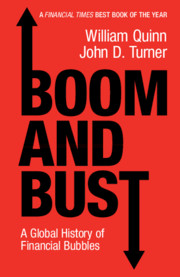Book contents
- Boom and Bust
- Boom and Bust
- Copyright page
- Contents
- Figures
- Tables
- Chapter 1 The Bubble Triangle
- Chapter 2 1720 and the Invention of the Bubble
- Chapter 3 Marketability Revived: The First Emerging Market Bubble
- Chapter 4 Democratising Speculation: The Great Railway Mania
- Chapter 5 Other People’s Money: The Australian Land Boom
- Chapter 6 Wheeler-Dealers: The British Bicycle Mania
- Chapter 7 The Roaring Twenties and the Wall Street Crash
- Chapter 8 Blowing Bubbles for Political Purposes: Japan in the 1980s
- Chapter 9 The Dot-Com Bubble
- Chapter 10 ‘No More Boom and Bust’: The Subprime Bubble
- Chapter 11 Casino Capitalism with Chinese Characteristics
- Chapter 12 Predicting Bubbles
- Acknowledgements
- Notes
- Bibliography
- Index
Chapter 7 - The Roaring Twenties and the Wall Street Crash
Published online by Cambridge University Press: 06 August 2020
- Boom and Bust
- Boom and Bust
- Copyright page
- Contents
- Figures
- Tables
- Chapter 1 The Bubble Triangle
- Chapter 2 1720 and the Invention of the Bubble
- Chapter 3 Marketability Revived: The First Emerging Market Bubble
- Chapter 4 Democratising Speculation: The Great Railway Mania
- Chapter 5 Other People’s Money: The Australian Land Boom
- Chapter 6 Wheeler-Dealers: The British Bicycle Mania
- Chapter 7 The Roaring Twenties and the Wall Street Crash
- Chapter 8 Blowing Bubbles for Political Purposes: Japan in the 1980s
- Chapter 9 The Dot-Com Bubble
- Chapter 10 ‘No More Boom and Bust’: The Subprime Bubble
- Chapter 11 Casino Capitalism with Chinese Characteristics
- Chapter 12 Predicting Bubbles
- Acknowledgements
- Notes
- Bibliography
- Index
Summary
Chapter 7 examines the bubble that occurred in the United States in the 1920s. The roaring twenties in the United States was a decade of increasing prosperity, the democratisation of investment and the development of transformative technology. Between the start of 1927 and October 1929, the Dow Jones Industrial Average increased 127 per cent. Then at the start of October 1929, the Wall Street crash occurred, and the market had lost 48 per cent of its value in a matter of five weeks. The chapter then moves on to explore how the bubble triangle explains the US bubble during the roaring twenties. The spark was electrification, which rapidly transformed the American economy. Marketability was high due to the new financial-market infrastructure in place to channel the massive savings of the middle classes towards governments and firms. Monetary conditions were not excessively loose, but the rapid rise of broker loans and buying on margin meant that there was a lot of credit underpinning investment in stocks. Speculation was rampant, with many ordinary people buying stocks in the hope of a quick capital gain. The chapter concludes by examining the contribution of the bubble and Wall Street crash to the subsequent Great Depression.
Keywords
- Type
- Chapter
- Information
- Boom and BustA Global History of Financial Bubbles, pp. 115 - 133Publisher: Cambridge University PressPrint publication year: 2020



